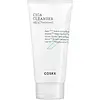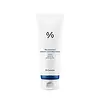What's inside
What's inside
 Key Ingredients
Key Ingredients

 Benefits
Benefits

 Concerns
Concerns

 Ingredients Side-by-side
Ingredients Side-by-side

Water
Skin ConditioningSodium Cocoyl Isethionate
CleansingGlycerin
HumectantGlyceryl Stearate
EmollientStearyl Alcohol
EmollientCoco-Betaine
CleansingSodium Methyl Cocoyl Taurate
CleansingSodium Chloride
MaskingCoco-Glucoside
CleansingCaprylyl Glycol
EmollientGlyceryl Caprylate
EmollientCitric Acid
BufferingEucalyptus Globulus Leaf Oil
PerfumingDisodium EDTA
Ocimum Basilicum Oil
Masking1,2-Hexanediol
Skin ConditioningQuillaja Saponaria Bark Extract
CleansingPropanediol
SolventCentella Asiatica Extract
CleansingCentella Asiatica Leaf Extract
Skin ConditioningCentella Asiatica Root Extract
Skin ConditioningSaccharomyces Ferment
Skin ConditioningEthylhexylglycerin
Skin ConditioningAsiatic Acid
Skin ConditioningAsiaticoside
AntioxidantMadecassic Acid
Skin ConditioningMadecassoside
AntioxidantPinus Pinaster Bark Extract
AntioxidantWater, Sodium Cocoyl Isethionate, Glycerin, Glyceryl Stearate, Stearyl Alcohol, Coco-Betaine, Sodium Methyl Cocoyl Taurate, Sodium Chloride, Coco-Glucoside, Caprylyl Glycol, Glyceryl Caprylate, Citric Acid, Eucalyptus Globulus Leaf Oil, Disodium EDTA, Ocimum Basilicum Oil, 1,2-Hexanediol, Quillaja Saponaria Bark Extract, Propanediol, Centella Asiatica Extract, Centella Asiatica Leaf Extract, Centella Asiatica Root Extract, Saccharomyces Ferment, Ethylhexylglycerin, Asiatic Acid, Asiaticoside, Madecassic Acid, Madecassoside, Pinus Pinaster Bark Extract
Water
Skin ConditioningMyristic Acid
CleansingGlycerin
HumectantPotassium Hydroxide
BufferingLauric Acid
CleansingPalmitic Acid
EmollientStearic Acid
CleansingGlyceryl Glucoside
HumectantLauryl Betaine
CleansingPolyglyceryl-2 Stearate
EmulsifyingBeeswax
Emulsion StabilisingGlyceryl Stearate
EmollientStearyl Alcohol
EmollientCitrus Aurantium Dulcis Peel Oil
MaskingCitrus Paradisi Peel Oil
MaskingCitrus Aurantium Bergamia Fruit Oil
MaskingButylene Glycol
HumectantGlucose
HumectantDisodium EDTA
Melaleuca Alternifolia Leaf Oil
AntioxidantHydrolyzed Hyaluronic Acid
HumectantCitrus Limon Fruit Extract
MaskingHippophae Rhamnoides Fruit Extract
Skin ConditioningCitrus Aurantium Dulcis Fruit Extract
MaskingGlycyrrhiza Glabra Root Extract
BleachingLactobacillus Ferment Lysate
Skin Conditioning1,2-Hexanediol
Skin ConditioningSodium Hyaluronate
HumectantCandida Bombicola/Glucose/Methyl Rapeseedate Ferment
AntimicrobialLactobacillus Ferment
Skin ConditioningLactococcus Ferment Lysate
Skin ConditioningBifida Ferment Filtrate
Skin ConditioningBifida Ferment Lysate
Skin ConditioningSaccharomyces Ferment Filtrate
HumectantWater, Myristic Acid, Glycerin, Potassium Hydroxide, Lauric Acid, Palmitic Acid, Stearic Acid, Glyceryl Glucoside, Lauryl Betaine, Polyglyceryl-2 Stearate, Beeswax, Glyceryl Stearate, Stearyl Alcohol, Citrus Aurantium Dulcis Peel Oil, Citrus Paradisi Peel Oil, Citrus Aurantium Bergamia Fruit Oil, Butylene Glycol, Glucose, Disodium EDTA, Melaleuca Alternifolia Leaf Oil, Hydrolyzed Hyaluronic Acid, Citrus Limon Fruit Extract, Hippophae Rhamnoides Fruit Extract, Citrus Aurantium Dulcis Fruit Extract, Glycyrrhiza Glabra Root Extract, Lactobacillus Ferment Lysate, 1,2-Hexanediol, Sodium Hyaluronate, Candida Bombicola/Glucose/Methyl Rapeseedate Ferment, Lactobacillus Ferment, Lactococcus Ferment Lysate, Bifida Ferment Filtrate, Bifida Ferment Lysate, Saccharomyces Ferment Filtrate
 Reviews
Reviews

Ingredients Explained
These ingredients are found in both products.
Ingredients higher up in an ingredient list are typically present in a larger amount.
1,2-Hexanediol is a synthetic liquid and another multi-functional powerhouse.
It is a:
- Humectant, drawing moisture into the skin
- Emollient, helping to soften skin
- Solvent, dispersing and stabilizing formulas
- Preservative booster, enhancing the antimicrobial activity of other preservatives
Disodium EDTA plays a role in making products more stable by aiding other preservatives.
It is a chelating agent, meaning it neutralizes metal ions that may be found in a product.
Disodium EDTA is a salt of edetic acid and is found to be safe in cosmetic ingredients.
Learn more about Disodium EDTAGlycerin is already naturally found in your skin. It helps moisturize and protect your skin.
A study from 2016 found glycerin to be more effective as a humectant than AHAs and hyaluronic acid.
As a humectant, it helps the skin stay hydrated by pulling moisture to your skin. The low molecular weight of glycerin allows it to pull moisture into the deeper layers of your skin.
Hydrated skin improves your skin barrier; Your skin barrier helps protect against irritants and bacteria.
Glycerin has also been found to have antimicrobial and antiviral properties. Due to these properties, glycerin is often used in wound and burn treatments.
In cosmetics, glycerin is usually derived from plants such as soybean or palm. However, it can also be sourced from animals, such as tallow or animal fat.
This ingredient is organic, colorless, odorless, and non-toxic.
Glycerin is the name for this ingredient in American English. British English uses Glycerol/Glycerine.
Learn more about GlycerinGlyceryl Stearate is a mix of glycerin and stearic acid.
It is used to stabilize the mixing of water and oil ingredients. By preventing these ingredients from separating, it can help elongate shelf life. It can also help thicken the product's texture.
As an emollient, it helps soften skin and supports barrier-replenishing ingredients.
In cosmetics, Glyceryl Stearate is often made from vegetable oils or synthetically produced.
This ingredient may not be fungal-acne safe
Fun fact: The human body also creates Glyceryl Stearate naturally.
Learn more about Glyceryl StearateStearyl Alcohol is a type of fatty alcohol from stearic acid. It is a white, waxy compound used to emulsify ingredients.
Fatty Alcohols are most often used as an emollient or to thicken a product. Emollients help soothe and hydrate the skin by trapping moisture.
They are usually derived from natural fats and oils and therefore do not have the same drying or irritating effect as solvent alcohols. FDA allows products labeled "alcohol-free" to have fatty alcohols.
Learn more about Stearyl AlcoholWater. It's the most common cosmetic ingredient of all. You'll usually see it at the top of ingredient lists, meaning that it makes up the largest part of the product.
So why is it so popular? Water most often acts as a solvent - this means that it helps dissolve other ingredients into the formulation.
You'll also recognize water as that liquid we all need to stay alive. If you see this, drink a glass of water. Stay hydrated!
Learn more about Water